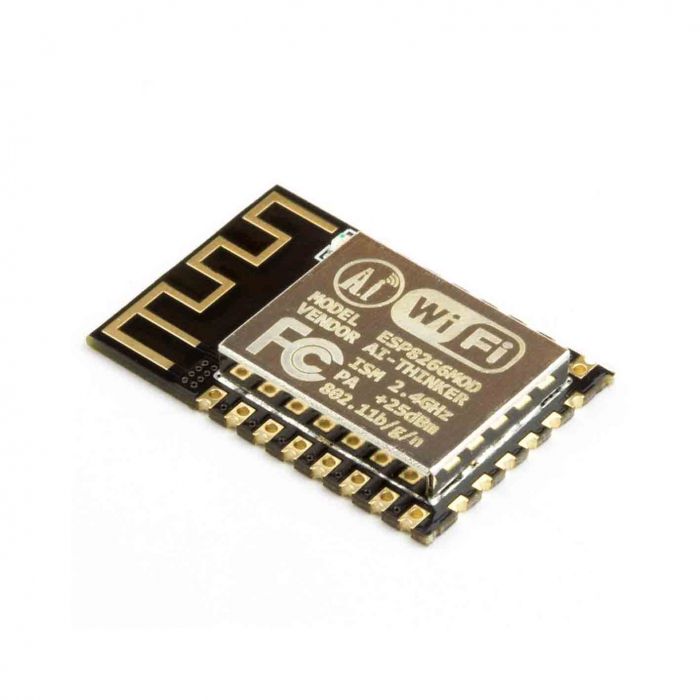Description
ESP8266 is a low-cost Wi-Fi chip with full TCP/IP stack and MCU (Micro Controller Unit) capability produced by Shanghai-based Chinese manufacturer, Espressif System
ESP8266 Serial Wifi Wireless Transceiver Module is a self contained SOC with integrated TCP/IP protocol stack that can give any microcontroller access to your WiFi network. ESP8266 Serial Wifi Wireless Transceiver Module is capable of either hosting an application or offloading all Wi-Fi networking functions from another application processor. Each ESP8266 module comes pre-programmed with an AT command set firmware, meaning, you can simply hook this up to your Arduino device and get about as much WiFi-ability as a WiFi Shield offers (and that’s just out of the box)! The ESP8266 module is an extremely cost effective board with a huge, and ever growing, community.
ESP8266 Serial Wifi Wireless Transceiver Module has a powerful enough on-board processing and storage capability that allows it to be integrated with the sensors and other application specific devices through its GPIOs with minimal development up-front and minimal loading during runtime. Its high degree of on-chip integration allows for minimal external circuitry, including the front-end module, is designed to occupy minimal PCB area. The ESP8266 supports APSD for VoIP applications and Bluetooth co-existance interfaces, it contains a self-calibrated RF allowing it to work under all operating conditions, and requires no external RF parts.
The first series of modules made with the ESP8266 by the third-party manufacturer AI-Thinker and remain the most widely available. They are collectively referred to as “ESP-xx modules”.
| Name | Active pins | Pitch | Form factor | LEDs | Shielded? | dimensions (mm) | Notes | |
|---|---|---|---|---|---|---|---|---|
| ESP-01 | 6 | 0.1″ | 2×4 DIL | Yes | PCB trace | No | 14.3 × 24.8 | |
| ESP-02 | 6 | 0.1″ | 2×4 castellated | No | U-FL connector | No | 14.2 × 14.2 | |
| ESP-03 | 10 | 2 mm | 2×7 castellated | No | Ceramic | No | 17.3 × 12.1 | |
| ESP-04 | 10 | 2 mm | 2×4 castellated | No | None | No | 14.7 × 12.1 | |
| ESP-05 | 3 | 0.1″ | 1×5 SIL | U-FL connector | No | 14.2 × 14.2 | ||
| ESP-06 | 11 | misc | 4×3 dice | No | None | Yes | 14.2 × 14.7 | Not FCC approved |
| ESP-07 | 14 | 2 mm | 2×8 pinhole | Yes | Ceramic + U-FL connector | Yes | 20.0 × 16.0 | Not FCC approved |
| ESP-08 | 10 | 2 mm | 2×7 castellated | No | None | Yes | 17.0 × 16.0 | Not FCC approved |
| ESP-09 | 10 | misc | 4×3 dice | No | None | No | 10.0 × 10.0 | |
| ESP-10 | 3 | 2 mm? | 1×5 castellated | No | None | No | 14.2 × 10.0 | |
| ESP-11 | 6 | 0.05″ | 1×8 pinhole | No | Ceramic | No | 17.3 × 12.1 | |
| ESP-12 | 14 | 2 mm | 2×8 castellated | Yes | PCB trace | Yes | 24.0 × 16.0 | FCC and CE approved[14] |
| ESP-12E | 20 | 2 mm | 2×8 castellated | Yes | PCB trace | Yes | 24.0 × 16.0 | 4 MB Flash |
| ESP-12F | 20 | 2 mm | 2×8 castellated | Yes | PCB trace | Yes | 24.0 × 16.0 | FCC and CE approved. Improved antenna performance. 4 MB Flash |
| ESP-13 | 16 | 1.5 mm | 2×9 castellated | No | PCB trace | Yes | W18.0 x L20.0 | Marked as ″FCC″. Shielded module is placed sideways, as compared to the ESP-12 modules. |
| ESP-14 | 22 | 2 mm | 2×8 castellated +6 | No | PCB trace | Yes | 24.3 x 16.2 |
Features
-
- Dimensions: 24mm x16mm x 3mm / 0.9″ x 0.6″ x 0.1″
- Weight: 2g
- 4MB Flash
Tutorials
Resources
- ESP8266 specification sheet
- FCC test report for the module (FCC ID: 2AHMR-ESP12S)
- FCC test report for the ESP-12F module (FCC ID: 2AL3B-ESP-F)
- Huuuuge amount of information on http://www.esp8266.com/ community forum!
- NodeMCU (Lua for ESP8266) webpage with examples and documentation on the Lua framework
- Arduino IDE support for ESP8266


Robo Admin T –
Good and trustable product